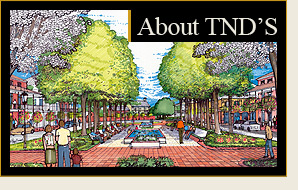| |
 Planning Principles Planning Principles
Since World War II, cities have been spreading ever-outward. Strip malls, parking lots, highways, and housing tracts have sprawled over the landscape. In addition, if there is one thing that reduces the livability of most postwar suburbs, it is the fact that streets do not feel like pleasant, shared spaces.
Surfacing throughout Traditional Neighborhood Developments, an urban design movement called New Urbanism is changing the way our cities and towns are built. Since the suburban boom of the 1950s, urban design had taken a back seat. Recently, new urbanists have been working to rediscover this largely lost art, suggesting that excellent design that is respectful to its surroundings can make a dense neighborhood feel livable and open. New urbanist-based developments include walkable neighborhoods rather than large, single-use places with streets hostile to pedestrians. The unique principles that make up the foundation of these new neighborhoods allow people to walk in their own neighborhood, experiencing diversity in culture, neighbors and landscape views, all within a safe environment.
New Urbanism provides a range of housing choices, from apartments over storefronts to single-family homes with yards. Its principles are divided into three categories:
- The Region: Metropolis, City and Town
- The Neighborhood, the District, and the Corridor
- The Block, the Street, and the Building
New Urbanism calls for towns to develop in the appropriate style for their surroundings, while respecting their neighbors.
The word “neighborhood” gets tossed around a lot in real estate brochures, so it is important to be clear what it means. Each neighborhood has a center and an edge. The center should be a public space, whether a square, a green, or an important intersection.
The optimal size of a neighborhood is a quarter-mile from center to edge. For most people, a quarter mile is a five-minute walk. For a neighborhood to feel walkable, many daily needs should be supplied within this five-minute walk. That includes not only homes, but stores, workplaces, schools, houses of worship, and recreational areas.
The typical plan for most developments include cul-de-sac's which harbors difficult access points. The preferred solution which provides multiple driving and pedestrian routes to any one location is the method used by Traditional Neighborhood Developments.
In New Urbanism, streets are safe, comfortable, interesting places for people to walk and meet. Buildings open onto sidewalks, rather than parking lots. Windows and doors facing the sidewalk make streets safer, and more interesting, for everyone. In New Urbanism, the parking lots are typically smaller and occur more often. Landscaping is provided as a shading device which allows for a more enjoyable pedestrian experience. Green space is provided in an effort to separate the street and sidewalk. New urbanist streets can accommodate cars while also providing comfort and convenience for pedestrians, bicyclists, and wheelchair users.
Every year, it grows clearer that there is a tremendous market demand for real neighborhoods, for lively cities, and for regions with plenty of protected open space. Sugar Mill Olde Towne is a perfect example where harmonious design of a neighborhood leads to a better quality of life for all those who choose to live in this innovative community.
Please click here to access Related Links for TND information, as well as a comparative list between TND neighborhoods vs. conventional suburban neighborhoods.
|
|

